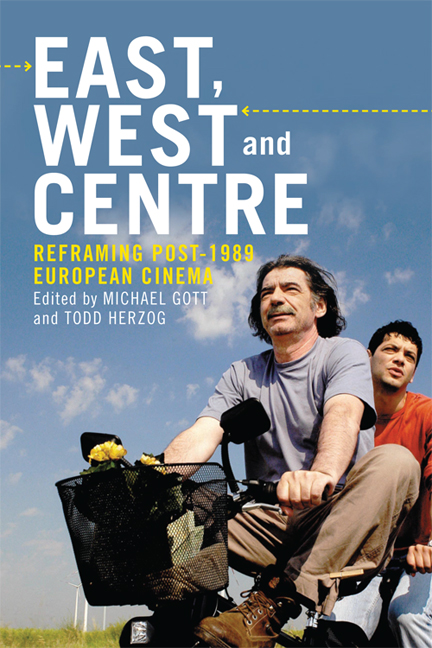Book contents
- Frontmatter
- Contents
- List of Figures
- Notes on Contributors
- Acknowledgements
- Introduction: East, West and Centre: ‘Mapping Post-1989 European Cinema’
- Part I Redrawing the Lines: De/Recentring Europe
- 1 The Berlin Wall Revisited: Reframing Historical Space between East and West in Cynthia Beatts's Cycling the Frame (1988), The Invisible Frame (2009) and Bartosz Konopka's Rabbit à la Berlin (2009)
- 2 Changing Sides: East/West Travesties in Lionel Baier's Comme des voleurs (à l'est)
- 3 Dubbing and Doubling Over: The Disorientation of France in the Films of Michael Haneke and Krzysztof Kieślowski
- 4 Challenging the East–West Divide in Ulrich Seidl's Import Export (2007)
- 5 Fatih Akın's Filmic Visions of a New Europe: Spatial and Aural Constructions of Europe in Im Juli/In July (2000
- 6 Salami Aleikum – The ‘Near East’ Meets the ‘Middle East’ in Europe
- 7 Cinematic Fairy Tales of Female Mobility in Post-Wall Europe: Hanna v. Mona
- Part II Border Spaces, Eastern Margins and Eastern Markets: Belonging and the Road to/from Europe
- Part III Spectres of the East
- Notes
- Bibliography
- Index
2 - Changing Sides: East/West Travesties in Lionel Baier's Comme des voleurs (à l'est)
from Part I - Redrawing the Lines: De/Recentring Europe
Published online by Cambridge University Press: 05 September 2016
- Frontmatter
- Contents
- List of Figures
- Notes on Contributors
- Acknowledgements
- Introduction: East, West and Centre: ‘Mapping Post-1989 European Cinema’
- Part I Redrawing the Lines: De/Recentring Europe
- 1 The Berlin Wall Revisited: Reframing Historical Space between East and West in Cynthia Beatts's Cycling the Frame (1988), The Invisible Frame (2009) and Bartosz Konopka's Rabbit à la Berlin (2009)
- 2 Changing Sides: East/West Travesties in Lionel Baier's Comme des voleurs (à l'est)
- 3 Dubbing and Doubling Over: The Disorientation of France in the Films of Michael Haneke and Krzysztof Kieślowski
- 4 Challenging the East–West Divide in Ulrich Seidl's Import Export (2007)
- 5 Fatih Akın's Filmic Visions of a New Europe: Spatial and Aural Constructions of Europe in Im Juli/In July (2000
- 6 Salami Aleikum – The ‘Near East’ Meets the ‘Middle East’ in Europe
- 7 Cinematic Fairy Tales of Female Mobility in Post-Wall Europe: Hanna v. Mona
- Part II Border Spaces, Eastern Margins and Eastern Markets: Belonging and the Road to/from Europe
- Part III Spectres of the East
- Notes
- Bibliography
- Index
Summary
Following the collapse of the Iron Curtain and the subsequent enlargement of the European Union, immigrants from the former Eastern bloc have received increasing cinematic representation across the European continent. Concurrently, the past two decades have seen a considerable – albeit quantitatively less significant – proliferation of road movies which focus on the opposite (West–East) trajectory, creating a diverse body of films that only recently has become the object of scholarly research. Though both categories of films have their own characteristics and can be juxtaposed in a variety of ways – ‘negative’ versus ‘positive’ voyages (Gott and Schilt 2013), ‘trafficking’ (Brown, Iordanova and Torchin 2010) versus ‘travelling’ (Mazierska and Rascaroli 2006) – most of these films share a strong involvement with the increasing impact of transnational mobility on the continent's sociocultural space in the aftermath of the Cold War.
This chapter examines the francophone Swiss production Comme des voleurs (a l'est) Stealth (2006), the second feature film of the Lausannebased film-maker Lionel Baier. For a variety of reasons, Stealth is rather atypical in its engagement with the shifting East/West divide after 1989. First of all, Baier combines within a single narrative various aspects of both ‘travelling’ and ‘trafficking’ along the East/West axis: while the first part of the film largely revolves around the encounters between the Swiss main character (Lionel Baier, played by the director himself) and an undocumented Polish au pair (Ewa), the second part of the film shifts focus to a turbulent road trip from Lausanne to Warsaw undertaken by the protagonist and his older sister Lucie. What is more, though both portions of the film – at least at first sight – would seem to be aligned with the bulk of European films dealing with post-1989 migration and transnational mobility, Baier's authorial approach adds a particular twist to various narrative tropes and cinematic conventions that typify the on-screen treatment of East/West encounters.
One of its most significant examples relates to the narrative thread of inter-ethnic coupling which plays a prominent role in both parts of the film. As I have argued elsewhere (Van Heuckelom 2011, 2013), many films dealing with post-Wall westbound (especially Polish) labour migration tend to combine images of a troubled host society with the portrayal of vigorous newcomers from the East who possess the physical and mental potential to rejuvenate the Old Continent and restore its disintegrating social and moral frameworks.
- Type
- Chapter
- Information
- East, West and CentreReframing post-1989 European Cinema, pp. 37 - 50Publisher: Edinburgh University PressPrint publication year: 2014



